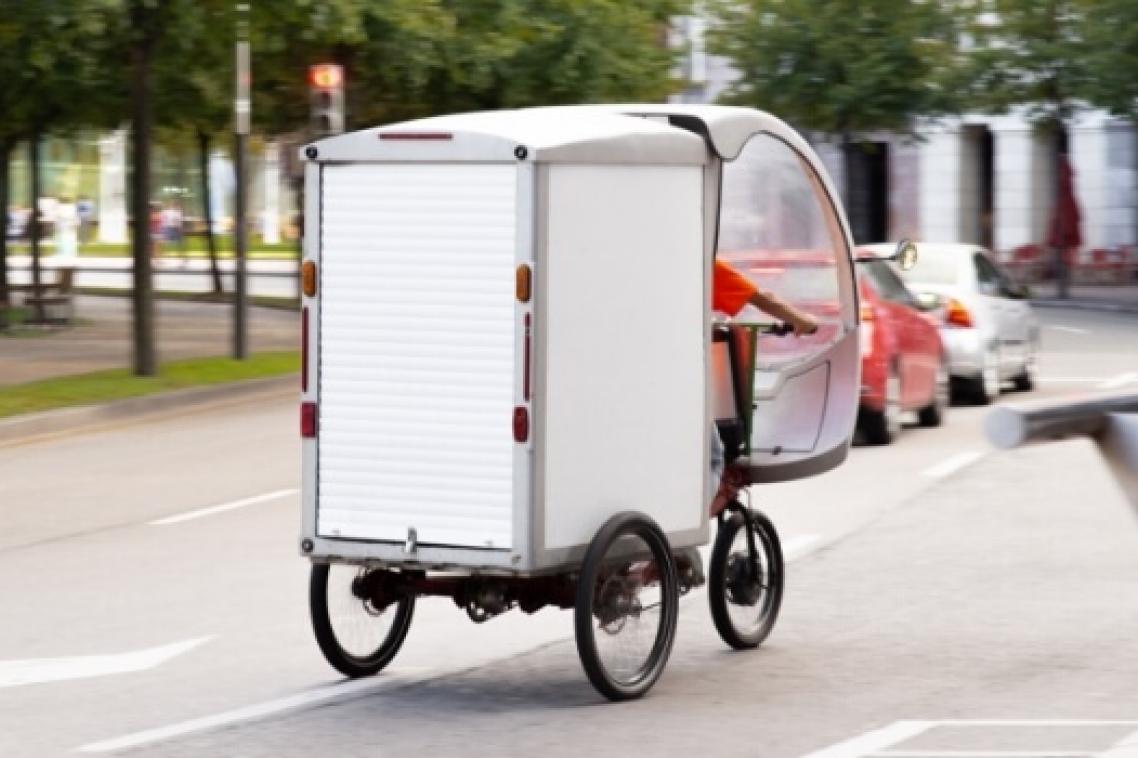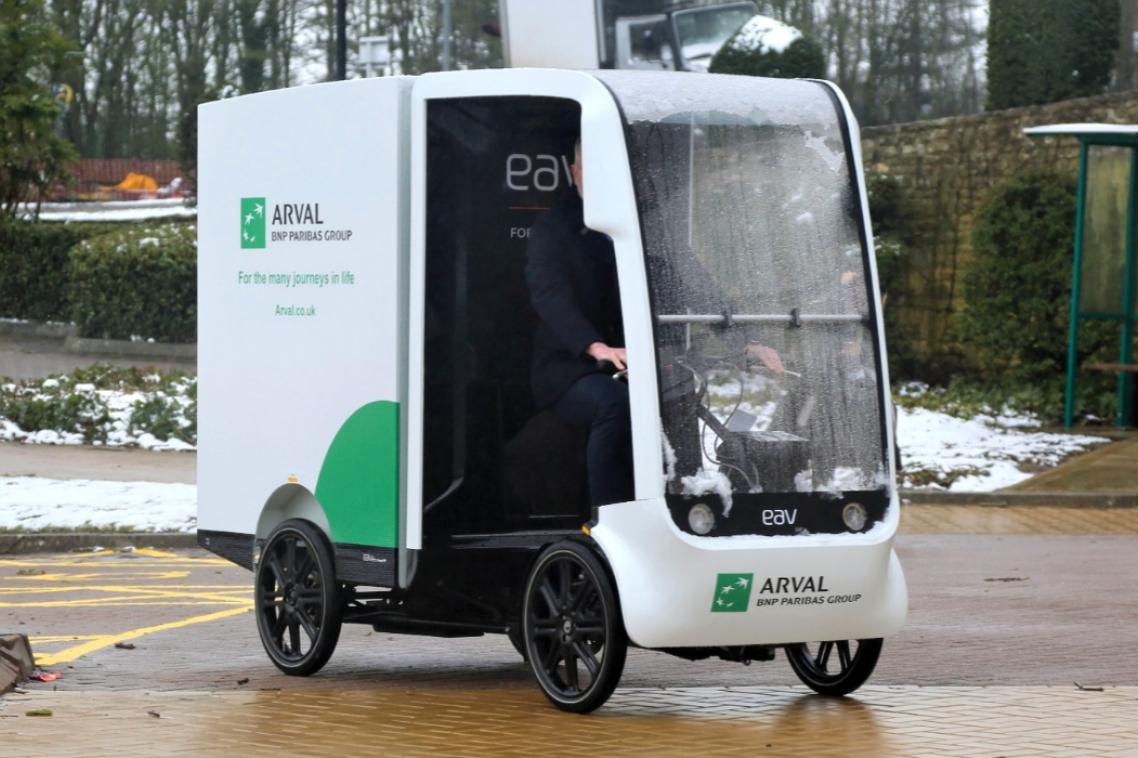
e-Cargo bikes
What is an e-Cargo bike?
e-Cargo bikes are an electric assisted version of the traditional cargo bike and can carry a similar load to a small vehicle. The electrification supports the transport of heavier loads, allowing for easy transportation with less rider power required, particularly in hilly terrain. An e-Cargo bike will have a built-in cargo area at the front or back, and can handle more load than an ordinary bike, thanks to the specifically designed frame and drivetrain.
Benefits
Economical
Efficiency
No licence required

Why businesses should adopt e-Cargo bikes
In congested cities, e-Cargo bikes can travel faster than cars and vans. In 2018, central London’s average traffic speed on weekdays was 11.4 km/h. For bikes, it was 15 km/h as they can access cycle lanes and navigate smaller streets. Different studies comparing delivery vans to e-Cargo bikes also show that they can deliver up to 60% faster, and that is likely to increase as cycling infrastructure improves.

Which businesses can use e-Cargo bikes
e-Cargo bikes are ideal for ‘Last Mile Deliveries’ to make the last leg of a parcel’s journey in urbanised areas, so are suited to logistics companies. However, other sectors such as grocery delivery companies, laundry sectors, waste companies, food carts and businesses who need to transport tools and inventory are increasingly adopting the technology.
How Arval can help
Arval can provide the asset on operating lease, covering the purchasing, the depreciation, the financing and the remarketing of the asset. We can provide a preventative maintenance package for the e-Cargo bike and support on any ad hoc repairs. We also have facilities to store, move and recover the e-Cargo bikes (location depending). We can provide in-life support in terms of account management, downtime reporting and asset management. Get in touch today to find out more.
Frequently asked questions
While insurance is not a legal requirement to operate an e-Cargo bike, they can be expensive to replace or repair, so many operators will protect them with e-Cargo bike insurance.
Companies may also want to ensure their public liability insurance covers the use and operation of e-Cargo bikes as part of business activities. Check with your legal team or insurance provider to ensure you have sufficient cover.
The e-Cargo bikes offered through Arval adhere to law EN15194, the EU e-bike safety standard. This involves speed being limited to 15.5mph (25kmh) and the motor being limited to 250w.
For further information, visit www.gov.uk/electric-bike-rules
Depending on location, Arval can provide a preventative maintenance package via the OEM, or the client may opt to maintain the e-Cargo bike themselves.
As with any vehicle provided by Arval, the client is responsible for ensuring the vehicle is safe and roadworthy, undertaking any required maintenance checks at regular intervals.
Our suppliers also offer full mechanic training and virtual workshops.
Any Arval client, where we already provide fleet vehicles, is eligible to use an e-Cargo bike supplied by Arval. Please speak to your Account Manager for more information.
While there are no legal restrictions on age to use an e-Cargo bike, riders should have suitable knowledge and awareness of the highway code. Other restrictions on operation may be included in any insurance your company has in place. Please check with your insurance provider.
Typically, you do not need a licence to operate an e-Cargo bike, provided they adhere to the current laws and are classified as “electric bikes” or “Electrically Assisted Pedal Cycles (EAPC)”. The e-Cargo bikes offered through Arval adhere to law EN15194, the EU e-bike safety standard. This involves speed being limited to 15.5mph (25kmh) and the motor being limited to 250w.
While operators do not require a licence, we do recommend training for riders to familiarise them with the controls, before public use. The manufacturer can offer user orientation and training for your staff.
For further information, visit www.gov.uk/electric-bike-rules
The e-Cargo bike will come with all the equipment you need for use and charging. The battery is removed from the bike for charging and will charge from a standard 13A socket in approximately 6-7 hours.
e-Cargo bikes are easier to park than a car, and will take up much less space than a typical city car. However, they are bulky and overnight storage can be an issue if you don’t have a storage facility or suitable space. We recommend you consider it in the same way as a motorbike, using a secure storage location, heavy duty locks, and stored in a warm and dry environment.
While in use around a town or city, the rider will need to ensure the cargo compartment is locked between deliveries. This can be fitted with keys or electronic locks as required. The bike itself requires a key to be driven so the rider would remove this as they step off the bike to make a delivery, ensuring no-one is able to drive it away.
In addition, brake levers are equipped with an additional catch, which will ensure brakes are held in the ON position when in use. A lock can also be fitted to prevent the catch being released.
No. While e-Cargo bikes can be made to provide alternative transport solutions for passengers. Arval does not currently provide this as an option.
The e-Cargo bikes available from Arval are limited to 15.5mph (25kmh) and have 250w motors or smaller, and so are classified as normal pedal bikes. As such, they can be ridden anywhere where standard pedal bikes would be allowed. This includes:
- Shared use paths
- Cycle lanes
- Bus lanes
However, operators should consider that large four-wheel bikes of this type may be considered as anti-social or undesirable in restricted spaces, and therefore should continue to plan routes carefully to avoid damage or pedestrian inconvenience.
e-Cargo bikes have the same legal status as a regular bike, and should follow the appropriate rules and guidelines (e.g. not to be used on a motorway).
As e-Cargo bikes are classed as pedal bikes, cycling helmets should be worn. We also recommend the use of Hi-Vis coats or vests to increase visibility for other road users.
e-Cargo Bike loads range from 150kg to 250kg (excluding the driver) and care should be taken not to exceed this. Please speak to Arval about any specific requirements.
No. Anything you could transport with a car or van, can be transported by an e-Cargo bike, as long as the max load limit is not exceeded.
A certain amount of customisation to the cargo area is possible. Please speak to your Account Manager.
Yes. The bike (cargo area) can be branded to suit your brand requirements. Please speak to your Account Manager.
The bike is electrically assisted and is designed to be ridden for a long day without the rider getting tired. Pushing the pedals will engage the motor so rider effort levels can be lower.
The rider can adjust the level of assistance delivered, increasing power to help tackle long hills and reducing power for flat areas and low speed manoeuvring.
A typical 60Ah battery provides a maximum of 40m (65km) of range. Larger batteries are available and a secondary battery holder can also be added.
The battery is removed from the bike for charging and will charge from a standard 13A socket in approximately 6-7 hours.
Yes. ISO 12405-1:2011: Electrically propelled road vehicles, specifies test procedures for lithium-ion battery packs and systems for use in electrically propelled road vehicles.
Yes, the riders seat is adjustable to suit multiple riders. Each rider should adjust the seat height before use. This can easily be adjusted without any tools.
There are a number of daily checks that should be carried out before use. This includes:
- Tyres (tread and pressure)
- Brakes
- Lights
- Mirrors
- Windscreen
In addition, the rider should carry out a general visual inspection before use and report any issues to the fleet manager.
In addition, we recommend a programme of weekly and monthly checks, most of which can be carried out by a rider that has been trained in the operation of the e-Cargo bike.
Additional checks and maintenance should be carried out by a qualified mechanic and can be done in-house, if trained personnel are available, or by a locally approved cycle mechanic.
The manufacturer will help you assess your daily range requirements and specify the appropriate sized batteries for your needs. A typical 60Ah battery provides a maximum of 40m (65km) of range.
Larger batteries are available and a secondary battery holder can also be added to carry two batteries at a time. The batteries are ‘swappable’ meaning you can easily slide them into the battery holders to replace and charge.
